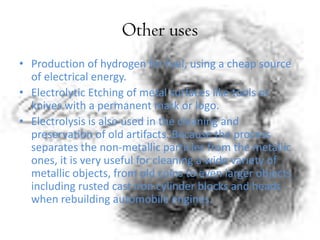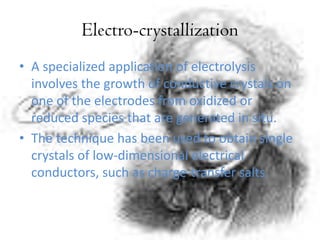This document provides an overview of electrolysis. It discusses the history of electrolysis, the process which involves using a direct electric current to drive a non-spontaneous chemical reaction. It also covers Faraday's laws of electrolysis, industrial uses such as producing aluminum and chlorine, and reactions that occur during electrolysis like the oxidation and reduction at electrodes. Specific techniques like electrolysis of water and electrocrystallization are also summarized.



![History
• The word electrolysis comes from the Greek ἤλεκτρον [ɛ̌ːlektron]
"amber" and λύσις [lýsis] "dissolution".
• 1785 – Martinus van Marum's electrostatic generator was used to
reduce tin, zinc, and antimony from their salts using electrolysis.[1]
• 1800 – William Nicholson and Anthony Carlisle (view also Johann
Ritter), decomposed water into hydrogen and oxygen.
• 1807 – Potassium, sodium, barium, calcium and magnesium were
discovered by Sir Humphry Davy using electrolysis.
• 1875 – Paul Émile Lecoq de Boisbaudran discovered gallium using
electrolysis.[2]
• 1886 – Fluorine was discovered by Henri Moissan using electrolysis.
• 1886 – Hall-Héroult process developed for making aluminium
• 1890 – Castner-Kellner process developed for making sodium
hydroxide.](https://image.slidesharecdn.com/aashif-140612133826-phpapp02/85/Aashif-4-320.jpg)
![Process of Electrolysis
• The key process of electrolysis is the interchange of atoms
and ions by the removal or addition of electrons from the
external circuit. The desired products of electrolysis are
often in a different physical state from the electrolyte and
can be removed by some physical processes. For example,
in the electrolysis of brine to produce hydrogen and
chlorine, the products are gaseous. These gaseous products
bubble from the electrolyte and are collected.[3]
• 2 NaCl + 2 H2O → 2 NaOH + H2 + Cl2 A liquid containing
mobile ions (electrolyte) is produced by:
• Solvation or reaction of an ionic compound with a solvent
(such as water) to produce mobile ions
• An ionic compound is melted (fused) by heating](https://image.slidesharecdn.com/aashif-140612133826-phpapp02/85/Aashif-5-320.jpg)



















